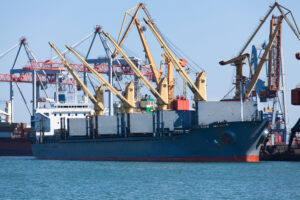The World Trade Organization (WTO) sharply downgraded its forecast for global merchandise trade, now projecting a 0.2 per cent decline in 2025, nearly three percentage points lower than what would have been expected under a “low tariff” baseline scenario.
The decline is expected to be particularly steep in North America, where exports are forecasted to drop by 12.6%.
This is premised on the tariff situation as of 14 April. The WTO also predicts that trade could shrink even further, to -1.5% in 2025, if the situation deteriorates.
Earlier on Wednesday, the U.N. Trade and Development (UNCTAD) said global economic growth could slow to 2.3% in 2025 as trade tensions and uncertainty drive a recessionary trend.
WTO Director-General Ngozi Okonjo-Iweala voiced deep concern by the uncertainty surrounding trade policy, including the US-China stand-off, warning of broader economic fallout. The enduring uncertainty threatens to act as a brake on global growth, with severe negative consequences for the world, the Director-General said.
At the start of the year, the WTO Secretariat expected to see continued expansion of world trade in 2025 and 2026, with merchandise trade growing in line with world GDP and commercial services trade increasing at a faster pace.
However, the large number of new tariffs introduced since January prompted WTO economists to reassess the trade situation, resulting in a substantial downgrade to their forecast for merchandise trade and a smaller reduction in their outlook for services trade.
Risks to the merchandise trade forecast persist, particularly from the reactivation of the suspended “reciprocal tariffs” by the United States, as well as the spread of trade policy uncertainty that could impact non-US trade relationships.
If realized, reciprocal tariffs would reduce global merchandise trade volume growth by 0.6 percentage points in 2025, the WTO said, adding that spreading trade policy uncertainty could shave off another 0.8 percentage points.
Together, reciprocal tariffs and spreading trade policy uncertainty would lead to a 1.5% decline in world merchandise trade in 2025.
Adding to the gloomy outlook, the WTO expects North America to see a 12.6% decline in exports and 9.6% drop in imports in 2025. The region’s performance would subtract 1.7 percentage points from world merchandise trade growth in 2025, turning the overall figure negative.
On the other hand, Asia is projected to post modest growth in both exports and imports this year (1.6% for both), along with Europe (1.0% export growth, 1.9% import growth).
“Both regions’ contributions to world trade growth would remain positive under current policies, albeit smaller than in the baseline low tariff scenario,” the WTO noted in its outlook.
Of particular concern is the growing rift between the US and China.
The disruption in US-China trade is expected to trigger significant trade diversion, raising concerns among third markets about increased competition from China.
Chinese merchandise exports are projected to rise by 4% to 9% across all regions outside North America, as trade is redirected, according to WTO.
At the same time, US imports from China are expected to fall sharply in sectors such as textiles, apparel, and electrical equipment, creating new export opportunities for other suppliers able to fill the gap.
Meanwhile, container throughput of major internation ports is a key indicator of global merchandise trade volumes. As of February 2025, the effects of US tariff increases were not yet evident in throughput data, WTO said, showing no clear positive or negative trend.
However European ports experienced a slight decline. Globally, month-on-month traffic growth in February was in line with the average of the past two years.
According to WTO, monthly throughput growth of Chinese ports in February, however, was stronger than the two-year average, possibly signalling increasing purchases in anticipation of the tariff increases in the United States.



